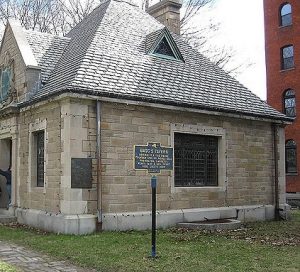Now this building, most people think it was Bagg’s Hotel. No it wasn’t. this building is a memorial building. When did all this happen? This all happened in the 1930s. The last person to own Bagg’s Hotel, after a long line of proprietors, was a man by the name of Thomas R. Proctor. Thomas Proctor was a magnificent benefactor to Utica. We’ve got all of Proctor’s parks, the park system, he bought it and gave it to Utica. Well, he owned this place. He died in 1920. So his wife, Mariah Proctor – Mariah Williams Proctor, she was a Williams girl – she inherited the hotel. By 1932 it was obvious that this hotel had met its best days, because by then you had Hotel Hamilton, you had hotel Utica, you had the St. James Hotel across the way, so there were a lot of newer hotels. And she decided that this hotel wasn’t worth rehabbing. She wanted to tear it down. So in 1932, as you can all remember what was going on in the 1930s? The Great Depression. So she decided that to tear the hotel down, she ordered them to use hand labor only. And her reason was a lot of people were out of work. If you did only hand labor you’d be able to employ more people, and give more people jobs. And then she ordered that all the wood from the hotel be piled here on Main Street and that any poor person to come along with their wagon or whatever they had to cart it away, and they could cart it away, because in those days most people used wood to heat their homes.
So this building is a memorial to Thomas Proctor. And the front door? Well, they don’t make em like that anymore.
It’s been here for since 1933. Nothing’s been done to it. You can see the bottom of it is being deteriorated. The hand knobber here, the knocker’s gone. Some say this door was the front door of the hotel. I can’t authenticate that. I don’t know that’s what I was told. It’s the door is very, very thick. How much is that? 4 inches maybe?

 You’ll see, on that far corner is where Samuel Morris and Samuel Chubbuck – Samuel Chubbuck by the way built the first commercial Telegraph key, Samuel Morris developed the telegraph itself right in the building on that corner. It’s called the Dudley Building.
You’ll see, on that far corner is where Samuel Morris and Samuel Chubbuck – Samuel Chubbuck by the way built the first commercial Telegraph key, Samuel Morris developed the telegraph itself right in the building on that corner. It’s called the Dudley Building.